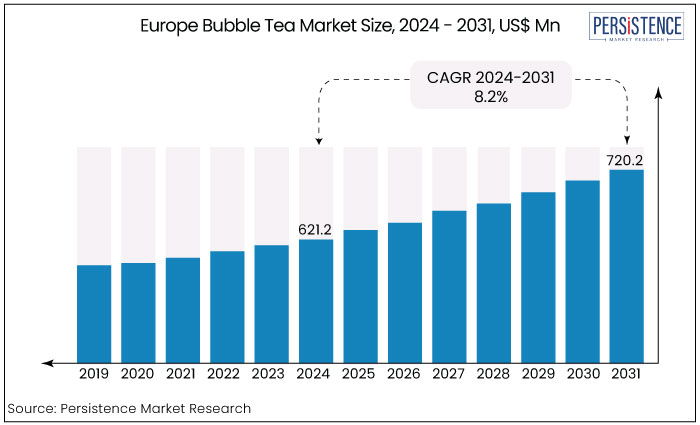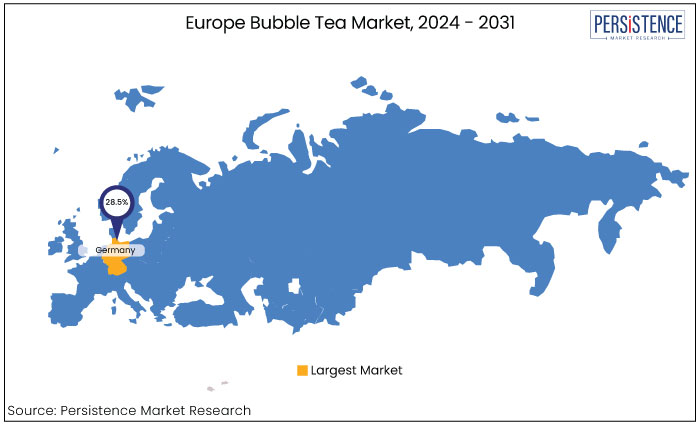Industry: Food and Beverages
Published Date: November-2024
Format: PPT*, PDF, EXCEL
Delivery Timelines: Contact Sales
Number of Pages: 190
Report ID: PMRREP34900
The Europe bubble tea market is estimated to increase from US$ 621.2 Mn in 2024 to US$ 720.2 Mn by 2031. The market is projected to record a CAGR of 8.2% during the forecast period from 2024 to 2031. Increasing prevalence of diabetes and obesity in countries like the U.K., Germany, and Italy is anticipated to push the development of low-sugar bubble tea.
According to Diabetes U.K., currently, more than 5.6 million individuals are living with diabetes in the U.K. Approximately 8% of individuals have type 1 diabetes, whereas 90% are living with type 2 diabetes in the country. With increasing diabetes cases, consumers are shifting toward low-sugar, plant-based bubble tea alternatives like soy and oat milk.

Key Highlights of the Market
|
Market Attributes |
Key Insights |
|
Europe Bubble Tea Market Size (2024E) |
US$ 621.2 Mn |
|
Projected Market Value (2031F) |
US$ 720.2 Mn |
|
Europe Market Growth Rate (CAGR 2024 to 2031) |
8.2% |
|
Historical Market Growth Rate (CAGR 2019 to 2023) |
6% |
|
Country |
Market Share in 2024 |
|
Germany |
28.5% |
Germany’s bubble tea market share is anticipated to rise to 28.5% in 2024. This growth is attributed to evolving consumer preferences and increasing demand for novelty beverages. Health-conscious millennial consumers are now seeking nutritious yet indulgent experiences. Bubble tea brands in Germany are hence offering a unique balance of customization, with options like fruit-based teas, low-sugar variants, and plant-based milk alternatives.
The country’s multicultural urban centers, such as Berlin, Hamburg, and Munich, serve as key hubs for international food trends. These are anticipated to foster demand for this unique drink among young consumers and tourists.
Germany’s well-developed café culture further aligns perfectly with bubble tea, allowing retailers to thrive through partnerships with tea houses, cafés, and food delivery platforms. Digitization in food services, such as the rising use of delivery apps, has further propelled bubble tea consumption, making it accessible beyond physical stores. Sustainability efforts are also gaining traction, with companies introducing biodegradable cups and reusable straws to cater to eco-conscious consumers.

|
Category |
Market Share in 2024 |
|
Flavor- Fruit-flavored Bubble Tea |
32.3% |
Fruit-flavored bubble tea is set to lead in terms of Europe bubble tea market growth in the forecast period. This is due to the broad appeal of the tea, its health perception, and availability of unique flavors. Consumers in Europe are increasingly shifting toward refreshing, lighter alternatives compared to traditional milk-based variants. Fruit flavors align with this trend by offering vibrant, natural tastes that cater to different palates.
Flavors like mango, passion fruit, and strawberry have gained significant traction, supported by their association with tropical and exotic appeal. Rising health consciousness among modern consumers is also set to push demand for fruit-based options. These drinks are often marketed as lighter and lower in calories, with a few variations, including real fruit juices or pulps.
|
Category |
Market Share in 2024 |
|
End User- Foodservice |
62.3% |
The foodservice segment dominates in terms of end user in the Europe bubble tea mix industry. This is due to its ability to drive consumer engagement through experiential dining and trendy beverage offerings.
Bubble tea aligns perfectly with the evolving preferences of younger consumers, who seek unique, ‘Instagrammable’ experiences when dining out. Cafés, restaurants, and specialized bubble tea chains actively leverage this demand. It is further positioning this tea as both a refreshing treat and a social experience. Foodservice providers also benefit from high foot traffic in urban areas, shopping malls, and tourist hubs, enhancing product visibility and impulse purchases.
The Europe bubble tea market has witnessed significant growth in recent years, driven by rising consumer interest in novel, customizable beverages. Originating in Taiwan, this tea has gained immense popularity across Europe, especially among younger audiences. They are attracted by its variety of flavors, colorful presentation, and unique textures like tapioca pearls and popping boba. This trend aligns with the growing demand for personalized food and drink experiences, allowing customers to personalize their drinks with various tea bases, toppings, and sugar levels.
Several new brands are coming up across Europe with innovative outlets in countries like Germany and the U.K. They are striving to develop cutting-edge production facilities to strengthen their supply chain. For instance,
The Europe bubble tea market secured a CAGR of 6% during the period from 2019 and 2023. This market growth attributed to increasing consumer interest in exotic beverages and customizable drink options from Asia Pacific. From its niche introduction in select metropolitan areas, bubble tea gradually expanded across Europe, with dedicated chains, pop-up stores, and cafés catering to the growing demand.
The bubble tea industry in Europe is predicted to surge at a remarkable CAGR of 8.2% through 2031. It will likely be driven by continuous product innovation, including the launch of fruit-based, organic, and sugar-free options to cater to evolving health trends. Key market players are anticipated to broaden their offerings with plant-based milk alternatives, appealing to vegan consumers and lactose-intolerant groups. Additionally, the shift toward sustainable packaging is anticipated to become a competitive differentiator as environmental concerns rise.
Influence of Oriental Culture in Europe to Bode Well for Market
The influence of oriental culture on global trends has significantly shaped the Europe beverage landscape, with bubble tea emerging as a quintessential example of this phenomenon. As modern consumers become increasingly enamored with cuisines from Asia Pacific, bubble tea has transitioned from a niche offering to a mainstream favorite. The beverage, originally from Taiwan, combines tea with chewy tapioca pearls. It offers a unique texture and flavor profile that appeals to the adventurous palates of younger demographics.
Cultural events, pop-up shops, and collaborations with Asia-themed festivals have further entrenched bubble tea demand in the social fabric of cities across Europe. It is hence gradually transforming the beverage into a symbol of trendy, social experiences.
The customizable nature of beverage allows for personalization, enabling consumers to craft novel drinks that resonate with their individual tastes and preferences. Consequently, the fusion of Asia’s culture with local influences has surged bubble tea's status. At the same time, it has fostered a vibrant community of enthusiasts eager to explore and celebrate this delightful drink.
Increasing Specialty Tea Shops Offering Customization Options to Boost Demand
The ongoing expansion of specialty tea shops and cafés dedicated to premium bubble tea is transforming the beverage segment in Europe. It is further significantly enhancing market growth and accessibility for consumers. These establishments go beyond traditional tea offerings. They mainly provide a curated menu that emphasizes high-quality ingredients, innovative flavor combinations, and artisanal preparation methods. By focusing on the craft of bubble tea, these shops attract a discerning clientele that seek not only unique taste experiences but also a visually appealing presentation.
The emphasis on customization is rising across Europe. Cafés and tea shops are allowing customers to choose from various tea bases, toppings, and sweetness levels. This creates a personalized experience that resonates with today’s consumers, particularly younger demographics who value individuality and creativity in their food and drink choices.
Competition to Surge from Traditional Tea and Coffee
The competition from already established beverage categories like coffee and traditional teas significantly challenges bubble tea brands seeking to carve out a niche in Europe. These beverages have deep-rooted cultural significance and established consumer bases, making it difficult for bubble tea to compete for attention and high market share.
Coffee, with its rich history and various preparation styles, is often seen as a staple in daily routines. Traditional teas, on the other hand, are integral to various cultures, offering a sense of familiarity and comfort. Additionally, these established beverages are widely available across multiple distribution channels- right from cafés to supermarkets. It is hence projected to create a complex infrastructure that bubble tea brands must navigate.
Inclusion of Sweeteners and Syrups May Lead to Diabetes and Obesity
Health concerns surrounding bubble tea have become increasingly prominent as consumers grow more aware of the implications of high sugar content and artificial ingredients. Several traditional bubble tea recipes rely heavily on sweeteners, syrups, and flavored powders. These can significantly increase calorie counts and contribute to health issues like obesity and diabetes. This growing awareness has prompted health-conscious consumers to scrutinize their beverage choices, leading them to seek options that align with healthy lifestyles. As a result, bubble tea may be perceived as an indulgent treat rather than a nutritious choice, limiting its appeal among this demographic.
Brands Use Plant-based Ingredients to Cater to High Demand from Vegans
Increasing popularity of veganism and plant-based diets presents a significant opportunity for bubble tea companies to innovate and extend their product offerings. By incorporating plant-based milk alternatives, such as almond, oat, coconut, or soy milk, bubble tea brands can cater to a diverse range of dietary preferences and restrictions. These options not only appeal to vegans but also to lactose-intolerant consumers seeking delicious and creamy beverages without dairy.
The use of plant-based toppings, such as fruit jellies, chia seeds, or coconut-based pearls, can enhance the flavor profile while maintaining a health-conscious appeal. This approach aligns with growing consumer awareness of sustainability. Several plant-based ingredients have a lower environmental impact compared to traditional dairy products. By marketing bubble tea as a customizable experience, brands can attract health-focused individuals who are eager to explore unique flavor combinations while still adhering to their dietary choices.
Companies Organize Workshops and Experiential Events to Attract Consumers
Organizing bubble tea workshops and experiential events presents a dynamic opportunity for brands to connect with consumers on a personal level while fostering community engagement. These hands-on workshops allow participants to learn the art of crafting their own bubble tea. These help them select the perfect tea base and flavoring as well as incorporate various toppings and textures. These interactive experiences mainly demystify the bubble tea-making process. In addition, they empower consumers to explore their creativity and customize their beverages to individual taste preferences.
The competitive landscape of the Europe bubble tea market is characterized by a mix of established players and emerging companies striving to innovate and capture market share. Key industry players, such as Döhler Group, Olam International, and Kerry Group, dominate the market by offering a diverse range of high-quality products.
Leading players are leveraging advanced processing technologies to maintain nutritional integrity. These companies focus on research and development activities to create unique tapioca pearls and functional ingredients that cater to health-conscious consumers and evolving dietary.
Recent Industry Developments
|
Attributes |
Details |
|
Forecast Period |
2024 to 2031 |
|
Historical Data Available for |
2019 to 2023 |
|
Market Analysis |
US$ Million for Value |
|
Key Regions Covered |
|
|
Key Market Segments Covered |
|
|
Key Companies Profiled |
|
|
Report Coverage |
|
|
Customization and Pricing |
Available upon request |
By Product Type
By End User
By Country
To know more about delivery timeline for this report Contact Sales

The market is projected to increase from US$ 621.2 Mn in 2024 to US$ 720.2 Mn by 2031.
Bubble tea has been gaining momentum since its emergence in Taiwan.
Brands in Europe are targeting young adults, teenagers, and children.
Yes, bubble tea shops can be profitable depending on factors like menu, technology, costs, quality, and marketing.
The bubble tea trend is gaining traction in the United Kingdom.s and Germany.